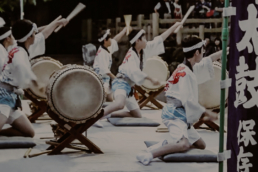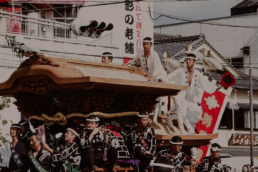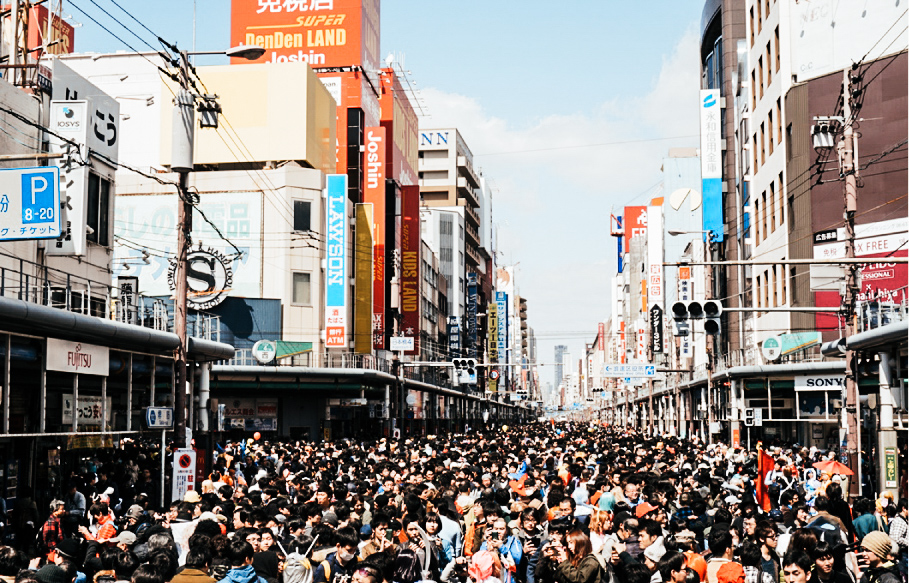Everything there is to know about Maneki Neko
Surely you have seen Maneki Neko, whether or not you are a fan of Japanese tradition. Shall we give this wonderful and lucky Japanese kitten special attention? Let's take a closer look at them.
Maneki Neko, the beckoning cat from Japan
Author: SaiKaiAngel
Also known as "lucky cat" is famous all over the world. The Maneki-Neko is a true Japanese symbol, with origins in Tokyo during the Edo period.
Originally Maneki Neko were made of wood, metal, porcelain or cast iron. Today they can be found in all kinds of materials, especially plastic.
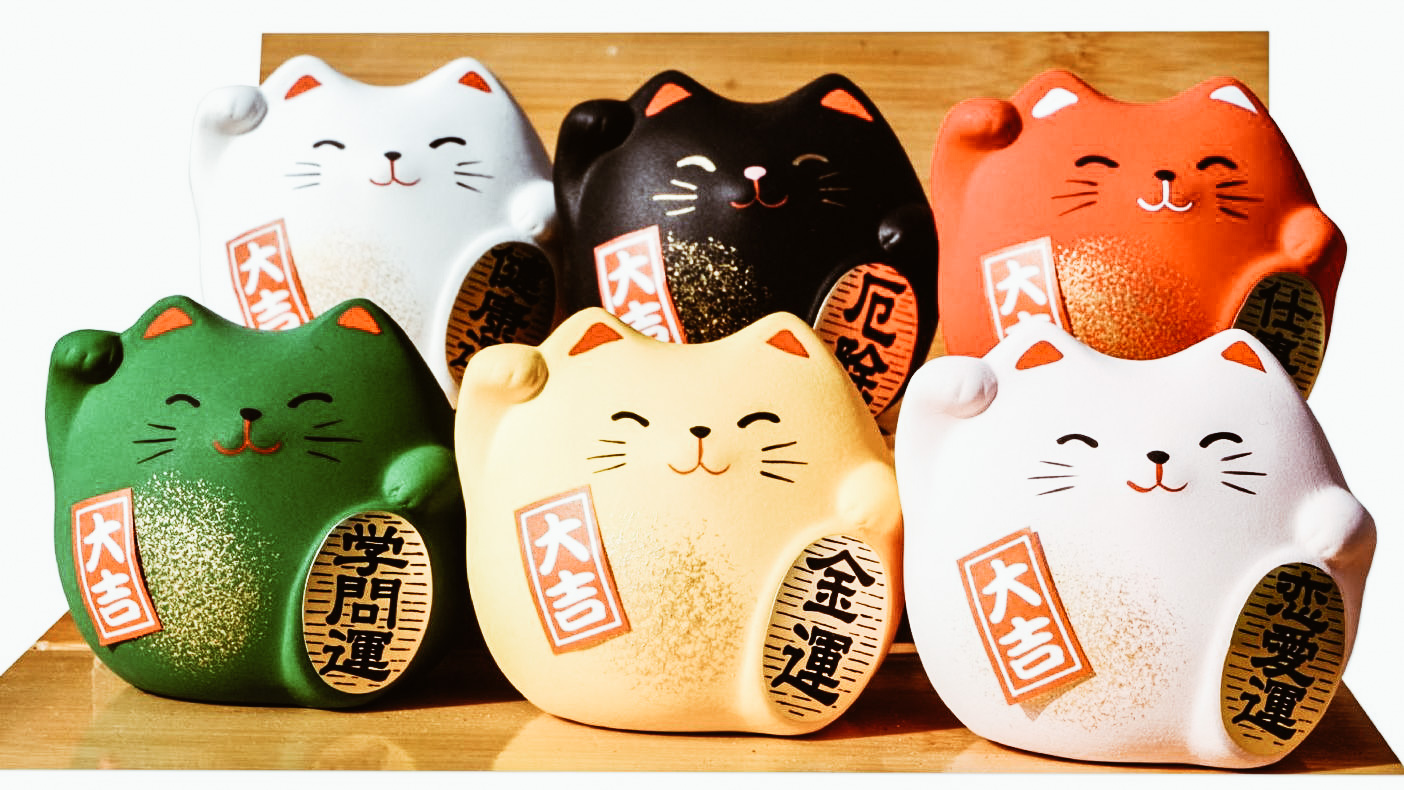
photo credits: www.dailyartmagazine.com
The origins
The origins are shrouded in mystery. There are some tales and the most famous is that of the samurai who, sitting in the rain under a large tree in front of a temple, was called with a nod of his paw. The samurai then headed towards him and at that very moment, a flash of light struck the tree under which he had been a few moments earlier. The cat then saved the samurai from certain death.
Another story tells of a shopkeeper who caught a cat in the rain, and the cat sat down in front of the shop, beckoning the customers to come in, as a sign of thanks.
Another legend, perhaps a little more bizarre, revolves around a courtesan who loved her domestic cat. The owner convinced that the cat was possessed, cut off his head in an attempt to exorcise it, just as a snake was about to bite the courtesan. The decapitated head flew in the air and landed on the snake, killing it instantly and saving the girl. The girl felt desperate because of the loss and, to give her a smile someone made her a statue of her cat, it seems that so was born the first Maneki-Neko.
The differences between Maneki Neko
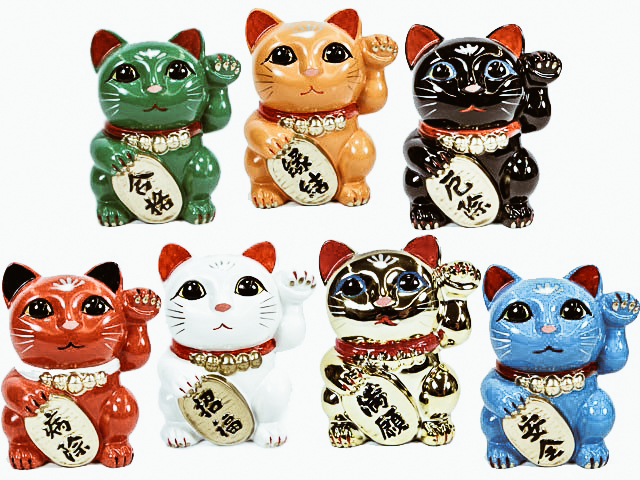
photo credits: @punamkhokhar
The cats all look similar, but if you look closely, you will discover even very small variations that change their meaning.
For example, depending on the position of the paw, Maneki Neko has different meanings:
- Left leg raised: attracts customers and good business. So Maneki Neko with the left paw raised is suitable for businesses, shops and activities that take place mainly at night such as nightclubs, bars and discos.
- Right leg raised: wish money and good luck.
- Both legs raised: it can mean "double luck!" and protection from bad luck, although the gesture can also be seen as a celebratory cheer. Obviously the legs must be at a different height because at the same height they would mean "surrendered" and obviously this is not the case of our Maneki Neko.
We can also occasionally find a coin together with the cat and this, of course, represents prosperity, wealth and money.
The bib and bell are generally associated with protection and abundance.
Who to give the Maneki Neko to?
Obviously, depending on the person we want to pay tribute to, it will be positioned differently. How to find the right place? Read here:
- At home: it should be located in the southeast part of the house, which is the wealth/money area.
- For work: Maneki Neko is usually kept close to the entrances so that people who enter can actually see it. If this is not possible, it can be kept in the northeast area of the business premises.
- For offices: place your Maneki Neko as close to the office as possible.
Of course, even depending on the colour, it has a different meaning, let's go see them all:
- Tricolour: attracts good luck, wealth, prosperity.
- White: the color of purity, white Maneki Neko attract purity and happiness.
- Black: they are seen as guards. They protect against negative energies and evil. They also help drive out stalkers and provide security, comfort and peace.
- Golden colour is associated with wealth and money. This Maneki Neko attracts material and monetary benefits and therefore can be found a lot in shops, restaurants and other workplaces.
- Red: red, like black, is a protector and is used to protect against evil and disease. It is good to keep one in the children's room.
- Pink: pink is the colour of love, so this Maneki Neko attracts love and romance.
- Green: this Maneki Neko helps students to increase their concentration towards their studies, protecting them from diseases and helping them to heal if they need it.
- Blue: attracts peace, harmony and happiness for family members.
Three ways to say "I Love you"
"Ti Amo, I love you" How do you say that in Japanese? There are so many kinds of love, why should we express love only one way? The Japanese know a lot, they know that every kind of love needs a way to be expressed, a completely personal way.
Ti Amo / I Love you, here's how to say it in Japanese
Author: SaiKaiAngel | Source: SoraNews24
All this, you think, happens in a country that is seen as "cold and distant". Perhaps, thinking about this, we should understand that cold and distant is not, indeed. It is a country that gives the right importance to history, tradition and feelings.
Let's start looking at all the ways of showing love in Japanese, let's analyze them one by one.
1. Suki - I like you

This is the most used and most famous way because it is found in many conversations of Japanese animation. We analyze it first also because it is the least "deep", in fact, more than love, it can also mean "I like". You can safely say "Ramen ga suki desu" that no one will see you as a fool in love with a plate of ramen, but everyone will understand that you like ramen. So you can use suki to express an appreciation for a singer or an actor too.
That's why suki can be confusing. If you hear this word, you might run into the question of whether you really like us as a person or just as a ramen dish. It's a very flexible meaning, not at all secure, yet it is used at the beginning of every love story. When you want to propose to someone, you can use suki desu to do so. Very important at that point, it will be the WAY in which you do it, you have to make the other person understand that you have serious intentions and you are not just a dish of ramen. It takes conviction in the voice, it's not a simple "I like". With a great conviction, then you will have the right colour of falling in love.
2. Koi - I love you

We're not talking about the carp, but the second way the Japanese use to talk about love. We're in the field of romantic love here. Koi is the young and passionate emotion, but it's rarely used to say "I love you". Maybe we can bring it closer to "I love you" by Americans, which can mean both "love you" and "deeply care about you". However, the verb koi suru is closer to "to be in love" or "to be romantically involved". In fact, the word Koi is used for Koibito meaning lover.
3. Ai - Ti Amo

And here we come to the most famous, the most used term for the word Love.
Ai is a noun that means "love", but it can be used for something more than just romantic affection. Ai or the variant aijo, are also used to talk about the concepts of love for the family, for a platonic love or for all humanity. Used as a verb, it becomes ai suru.
Then why do we use suki desu to confess our love? Simply because ai is a much more serious and committed feeling. Ai suru would be a bit... frightening, especially for a story that's just begun. We have to go step by step and Suki desu is what allows us to do that. It would also be better to change the verb suru to shiteiru. By telling your partner to the shiteiru, you're showing an ongoing love, not just an initial crush. As far as I'm concerned, it's the term I like best, also because it's the first one I've ever heard.

What does that tell us? That Japanese is a very romantic language despite what you hear. Are Japanese cold? All impression. Japanese can give the right meaning and depth to anything, even love. What term would you use for your love?
Atsuta Matsuri, lanterns and fireworks
There are many Japanese matsuri but today we decide to focus on Atsuta Matsuri, in the prefecture of Aichi.
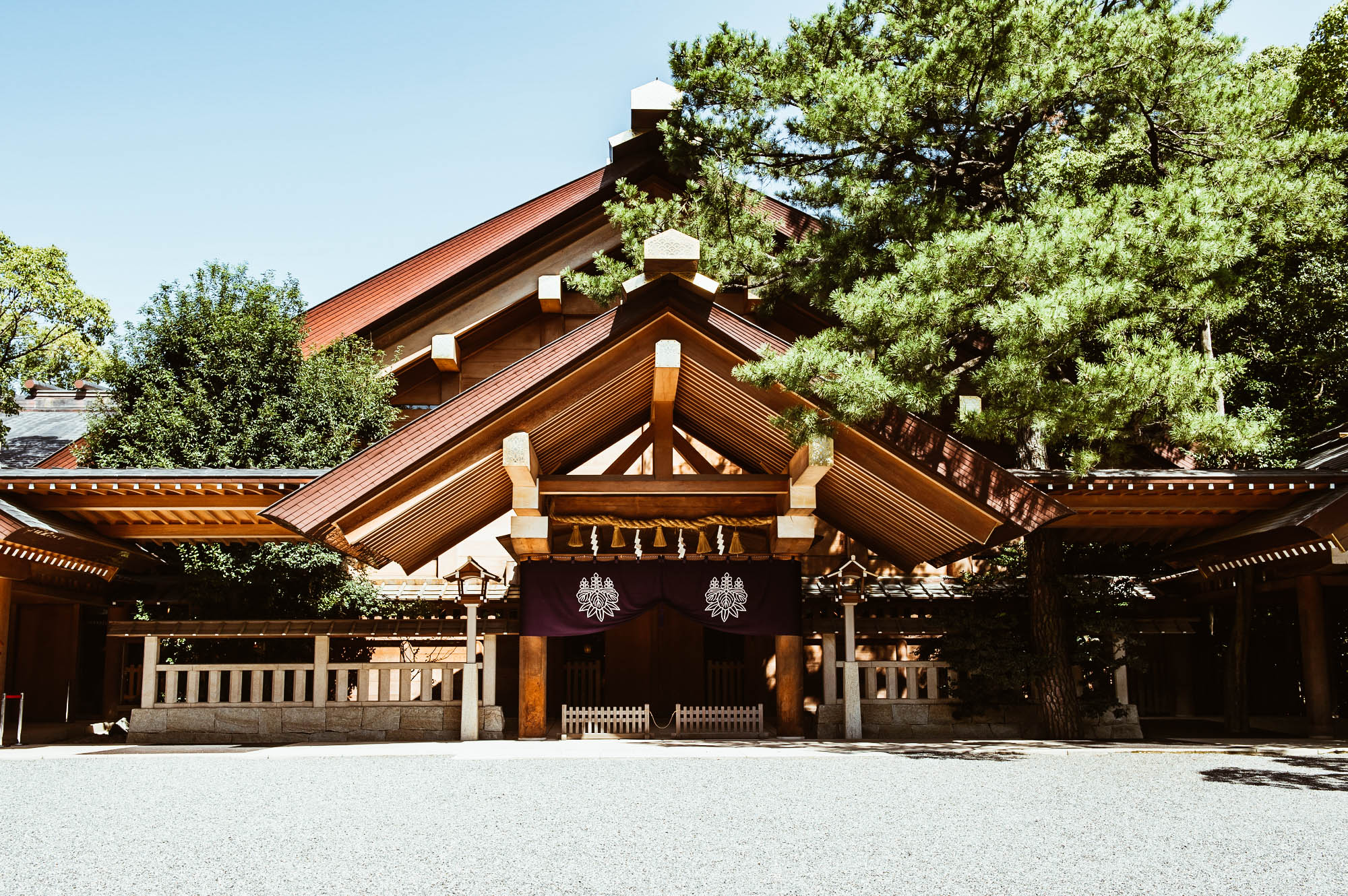
photo credits: thegate12.com
In the Chubu region, more precisely in Nagoya in the Aichi prefecture, if we enter the city, hidden among centuries-old cypresses, we will discover one of the most sacred shrines in Japan: the Atsuta Jingu. Venerated since antiquity with its 1900 years, it is believed to be the home of the Holy Kusanagi Sword of the Emperor, one of the three imperial insignia.
In this magical place, Atsuta Matsuri (諸ブー祭), better known as Shobu-sai, is held every year on June 5th.
Atsuta Matsuri day
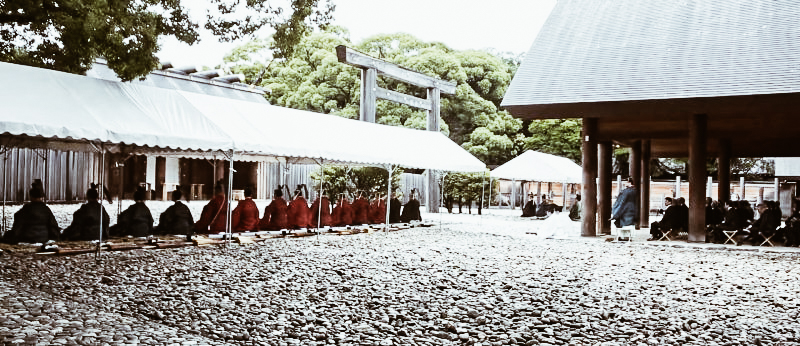
photo credits: kawaii-aichi.jp
Around 10:00 in the morning the celebrations begin with a special ceremony in which an imperial messenger is sent to the shrine to offer goheimotsu. These are in fact strips of white paper for Shinto rituals and which are used to celebrate a special ceremony dedicated to the gods and goddesses of Atsuta Jingu. After that, this splendid and characteristic Matsuri hosts various shows between the precincts of the Shrine.
The shows
The shows during this festival are many and varied, including kyudo, Japanese-style archery and kendo, Japanese fencing. But the real protagonist is the Atsuta-kagura, a type of traditional local Shinto dance accompanied by flutes and taiko, the typical Japanese drums. In addition to this, we find various performances including the Sumo and entertainment competitions such as the Kodomo Mikoshi, the portable shrines for children!


photo credits: kawaii-aichi.jp, goinjapanesque.com
The Festival reaches its climax when, at 18:00, the five makiwara kento, huge allegorical altars decorated with 365 lanterns each, are placed next to the entrances of the three torii doors of the sanctuary and are illuminated. Of course, there are stalls offering typical products and souvenirs of all kinds.
The chatter of people stops at 21:00 in the Jingu Koen park when a wonderful fireworks display raises heads and fills the eyes with lights and colors.


photo credits: goinjapanesque.com
The Atsuta Festival is the largest festival among the approximately 70 events held at the Atsuta Shrine every year.
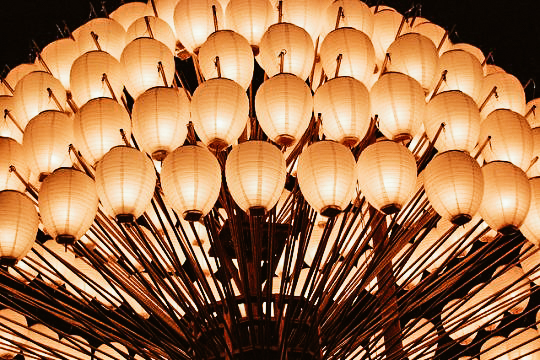

photo credits: nagmag.jp, kichijapan.com
If you are in the surrounding area, don't miss these magical lanterns and fireworks show to spend a fun day in the name of tradition! Like any festival, participation is free. For any information on how to reach the location, visit the official site of the Shrine in English.
Kitsunebi Matsuri, when folklore comes to life
In ancient Japanese folklore, the Kitsunebi (狐火, foxfire) was a yōkai that, overnight, suddenly appeared as a glowing red-orange and sometimes blue light. The Kitsunebi gradually increased to cover vast areas, reaching even 4km! It was believed that they were torches of a procession of foxes marching for their wedding. The lights were sighted by farmers in the mountains and were considered a good harbinger for the harvest. In fact, the greater the number of lights seen, the more fruitful was the harvest. However, no human was allowed to approach: those who tried were condemned to vanish.
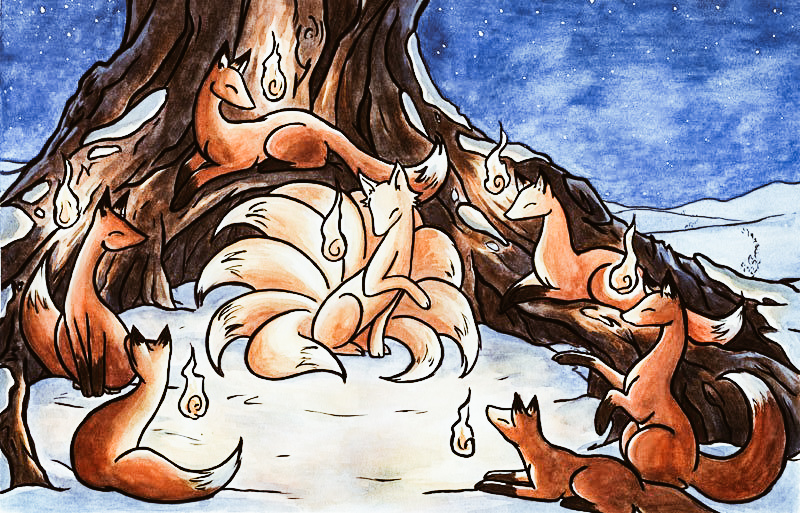
photo credits: tradurreilgiappone.com
In particular, the stories tell of the marriage between Otonosama, the king who lived in Furukawa, and Okon, the daughter of the fox God. This fascinating image is the origin of the Hida Furukawa Kitsunebi Matsuri (騨古川きつね火まつり). This festival is celebrated every year, on the fourth Saturday of September in Hida Furukawa, a picturesque and rural town full of beautiful landscapes, where even today you can breathe a life far from the frenzy of the metropolis.
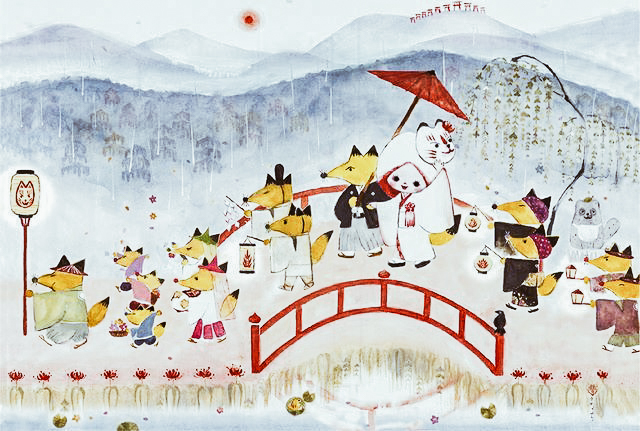
photo credits: tradurreilgiappone.com
Happiness and prosperity!
Like almost all the festivals we are used to now, the Kitsunebi Matsuri also aims to bless the harvest, happiness and prosperity for families.
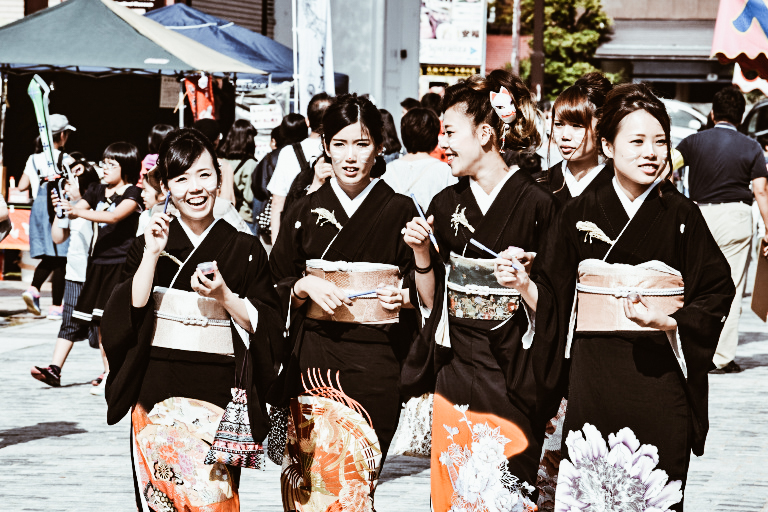
photo credits: myjapantravels.wordpress.com
But what exactly does the Kitsunebi Matsuri consist of??
First of all, all the participants have fox mustaches drawn on their faces, be they children or elderly, shopkeepers on the road or tourists. It begins with the blessing of local businesses: the dancers carry a dongamaki, a 5 meter long snake, door to door.
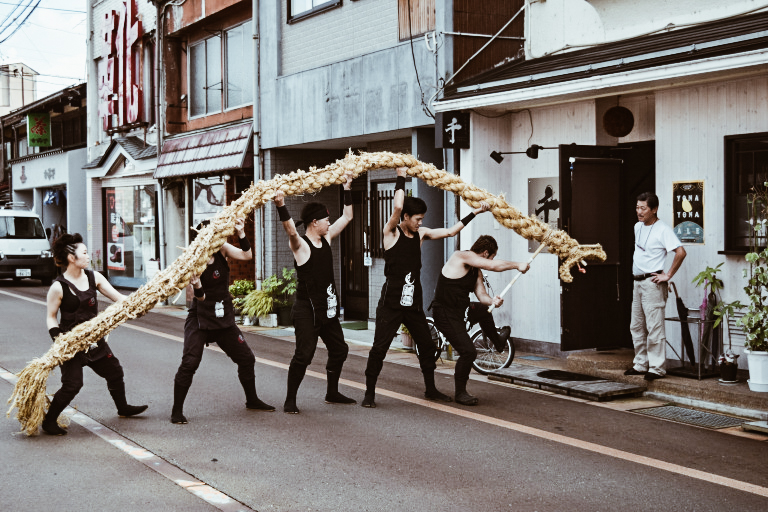
photo credits: myjapantravels.wordpress.com
After that the main event begins. We could say that it is a marriage, but not a common one, but a solemn procession in which the foxes' wedding is celebrated, the Kitsune no Yomeiri.

photo credits: myjapantravels.wordpress.com
The future spouses, a couple bound in real life, are chosen by a pool of candidates at the national level in the town where the wedding ceremony will be held. The long march will lead the bride to the groom as night falls when the Kistunebi begins (a torchlight procession). Those who attend the whole procession will be blessed and can make a wish like a good harvest, or happiness for their family or prosperity in business.

photo credits: tokyopic.com
A romantic curiosity
From 1392, throughout the Muromachi period until the end of the nineteenth century, when Western wedding ceremonies replaced traditional Japanese ceremonies, weddings were held at night and the bride was escorted to her new home by a parade of lights.
The Kishiwada Danjiri Matsuri and the rampant euphoria
Every year, generally during a weekend in mid-September, the streets of Kishiwada, a small town near Osaka, are invaded by the fervor and euphoria for the Kishiwada Danjiri Matsuri (岸和田だんじ祭).
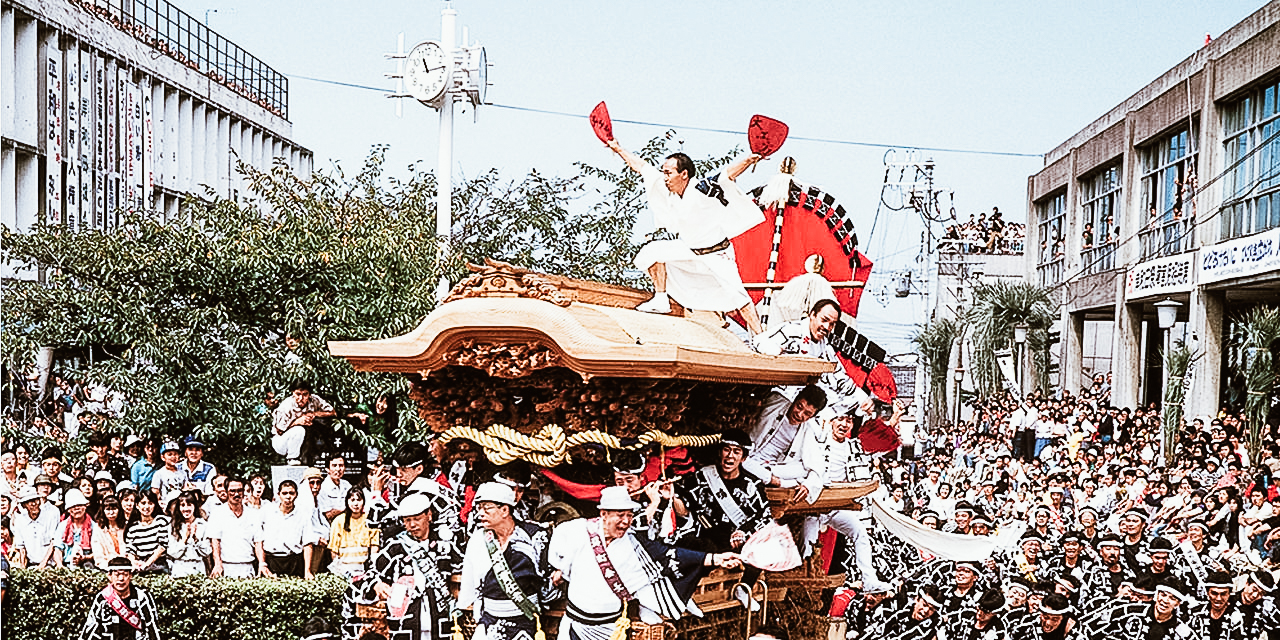
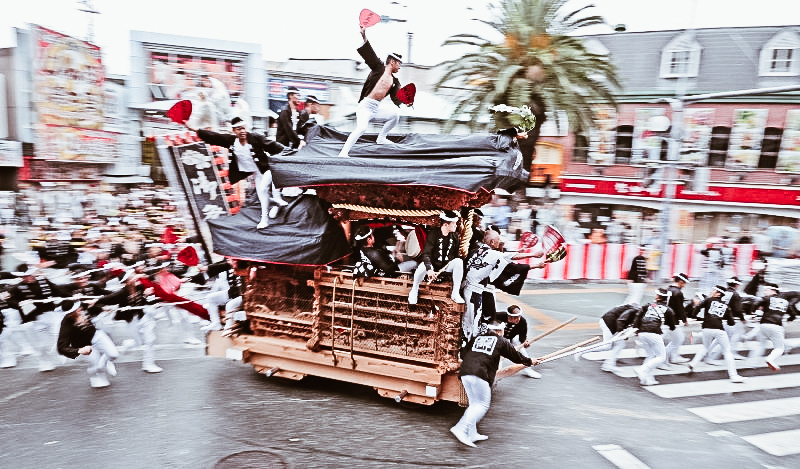
photo credits: airfrance.co.za, mainichi.jp
The celebrations originated in 1703, by the daimyō Okabe Nagayasu (部長泰). He prayed to the Shintoist gods for a bountiful harvest and this is still the meaning of the festival. However, what makes this celebration special is that it is a speed race pulling the danjiri.
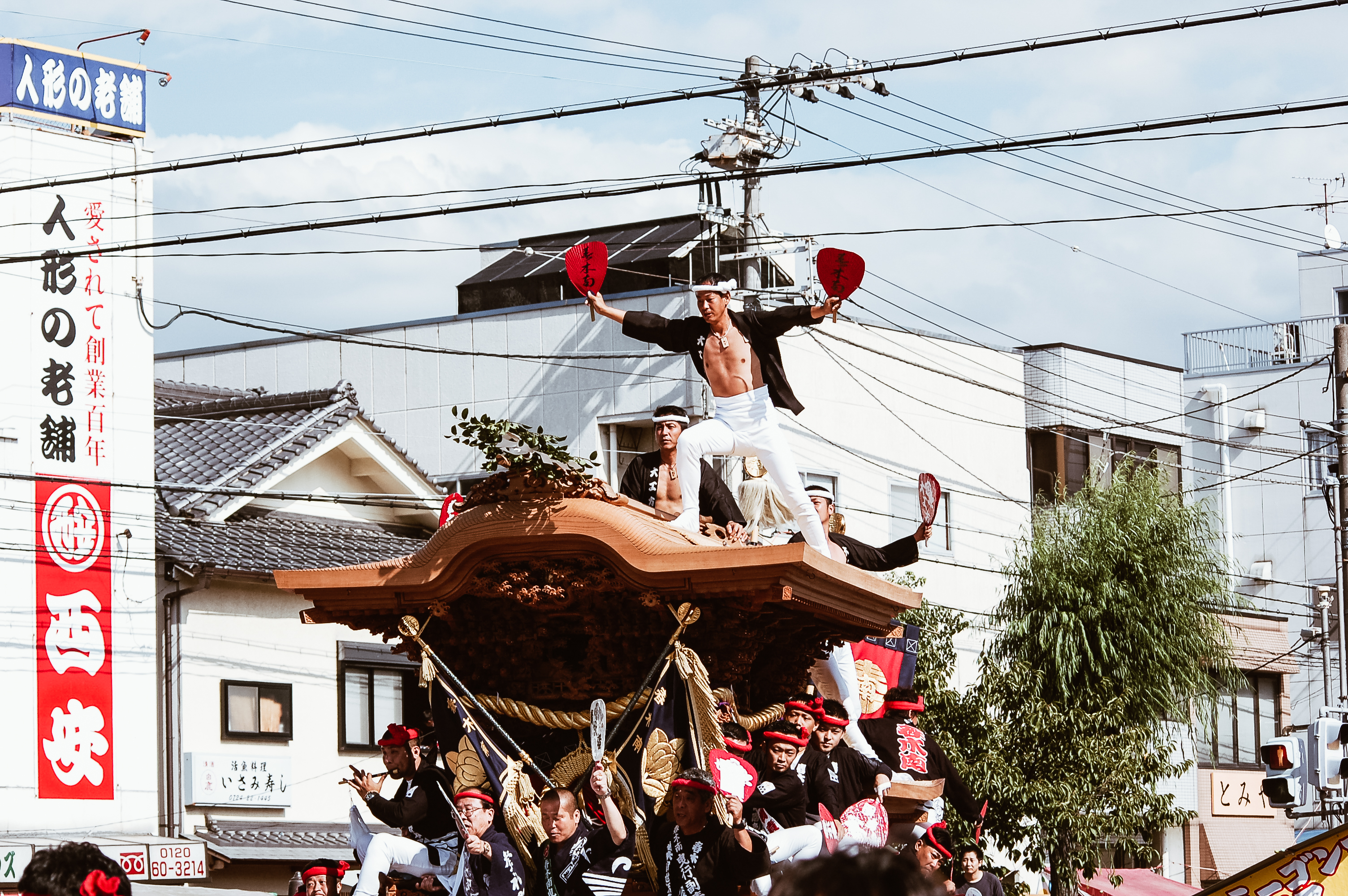

photo credits: Justin Yoshida
Danjiri are traditional wooden structures, carved and finely decorated by skilled carpenters and local sculptors. These wagons have the form of small shrines containing the deities and, during the days of the festival, they are precisely dragged through the streets of the neighborhood. Given their weight (they can exceed 3 quintals), the festival is also considered a moment to demonstrate one's courage. In fact, these structures must be towed with only the help of ropes and at full speed!
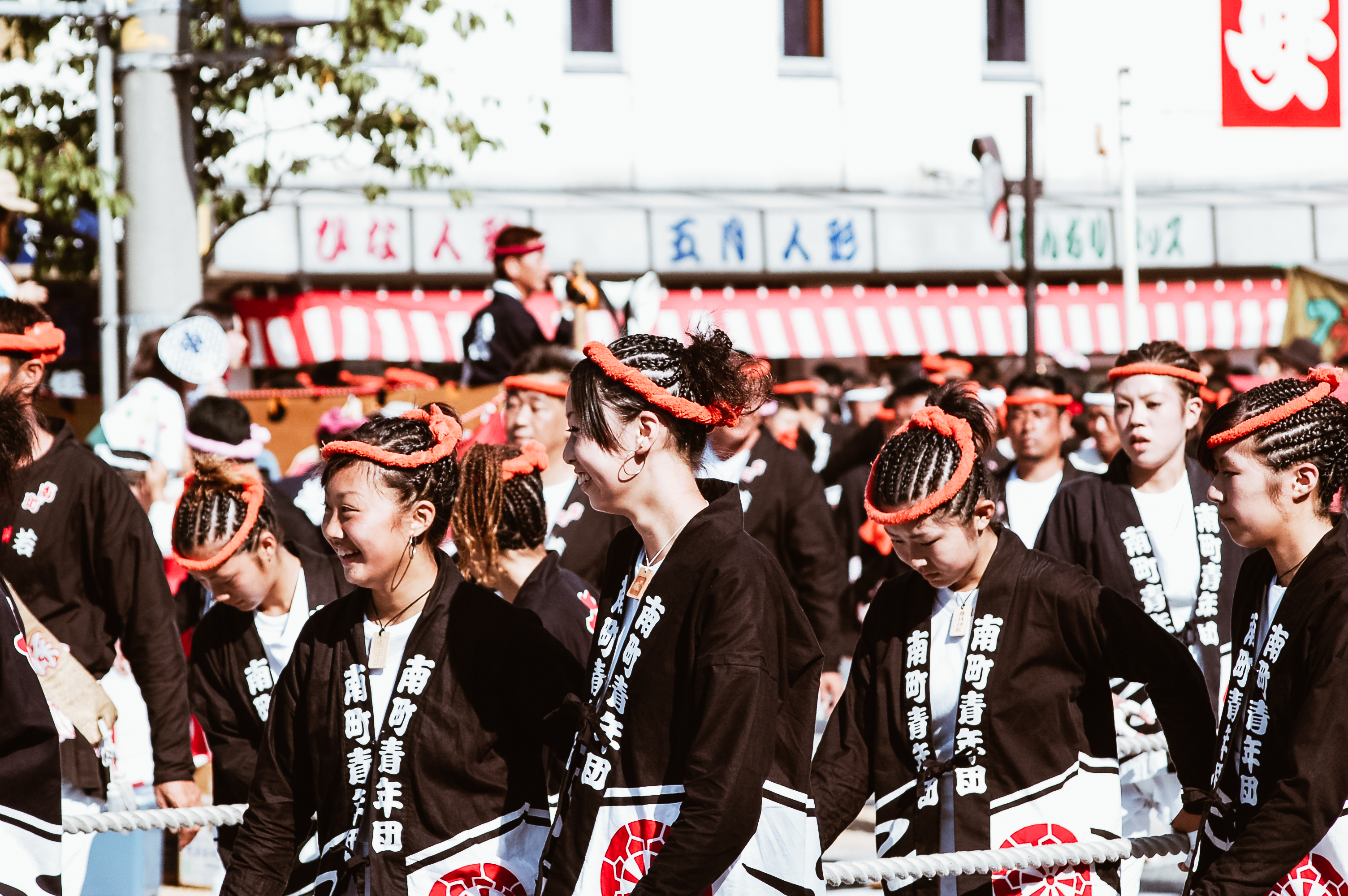
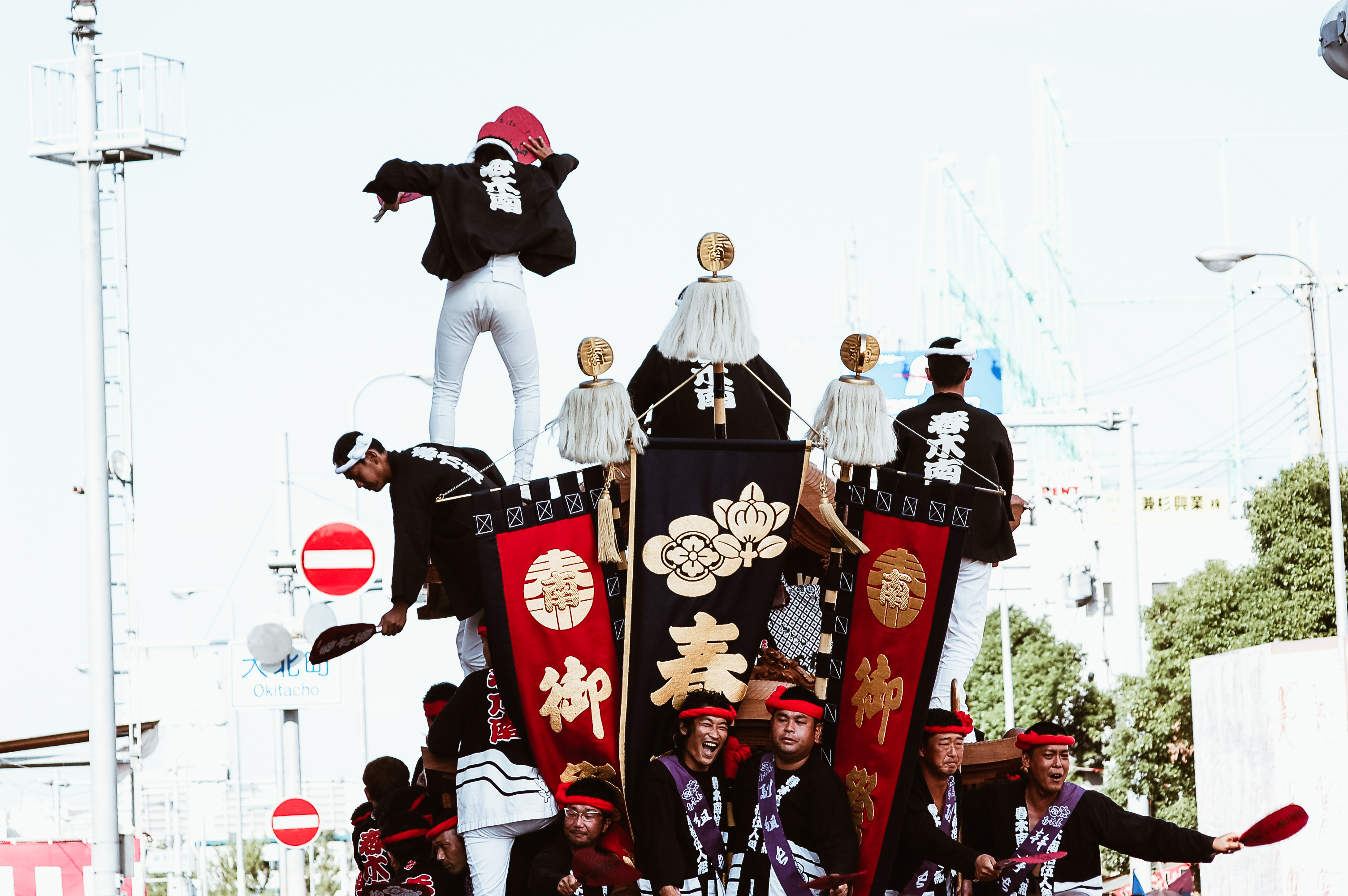
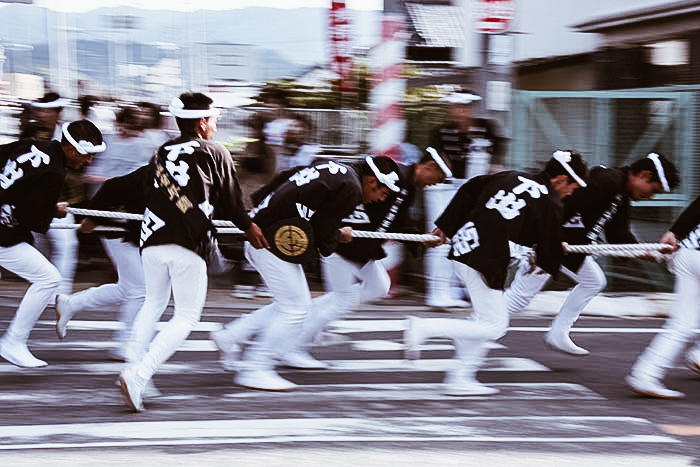

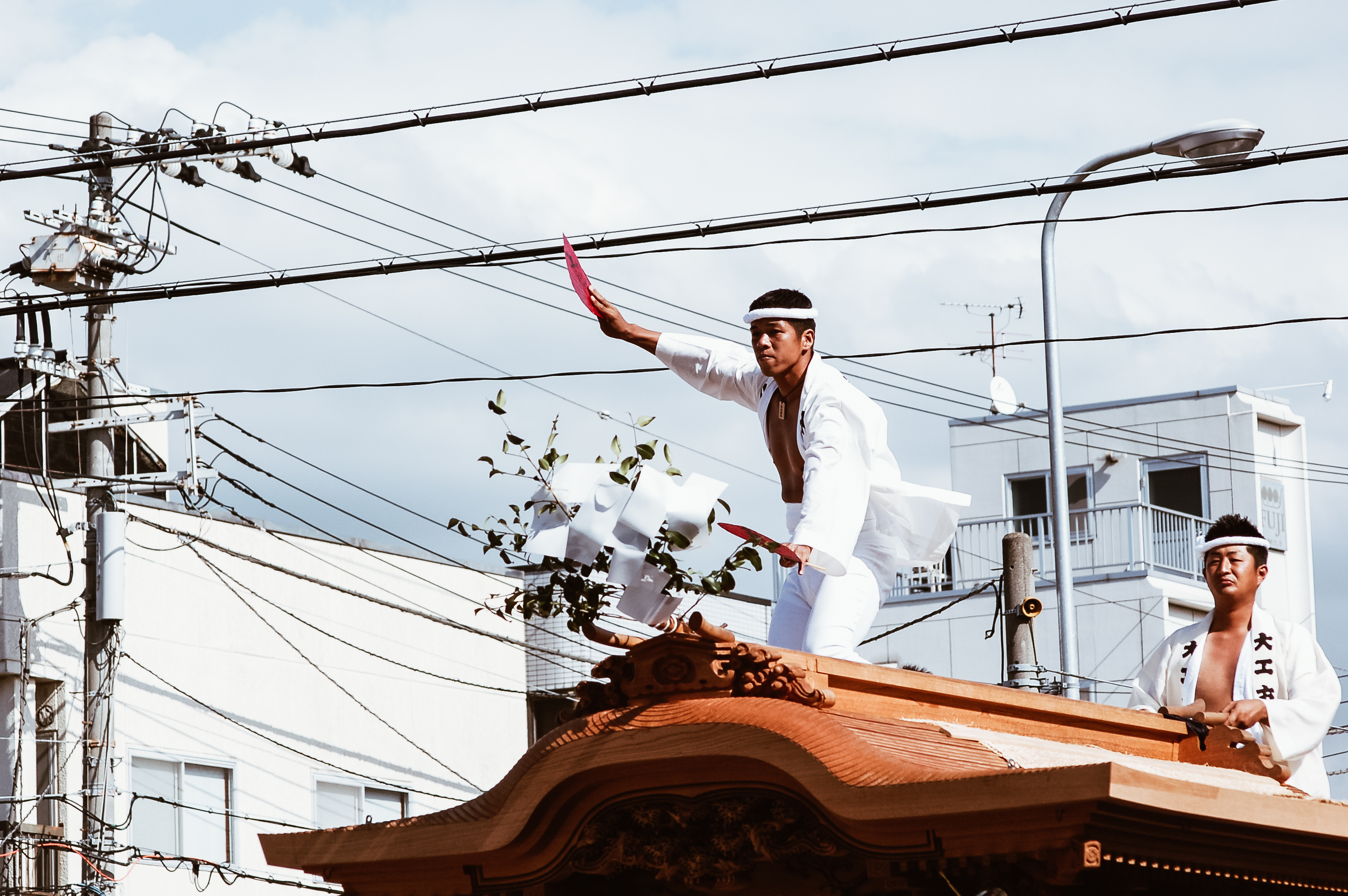
photo credits: Justin Yoshida, Justin Yoshida, japan-magazine.jnto.go.jp, MJY-shogun, Justin Yoshida
Kishiwada Danjiri Matsuri celebrations
During the festival celebrations, there are 35 danjiri involved, each of them being pulled by a team, representing the respective district of the city. At the control of the structure, on its top, there is the daiku-gata (大工方, master craftsman) whose wild dance serves as encouragement for his team and the crowd. Given the stunts in which he engages, the master craftsman risks his life constantly, but not only this! As we can easily imagine, this festival is also dangerous for all other participants due to the danjiri's dizzying speed. The wood splinters left behind and the fact that you have to elbow your way in to follow them is a danger to the crowd. Four hours of breathless running that ends with a big drinking moment around this wagon, to which dozens of paper lanterns are hung.
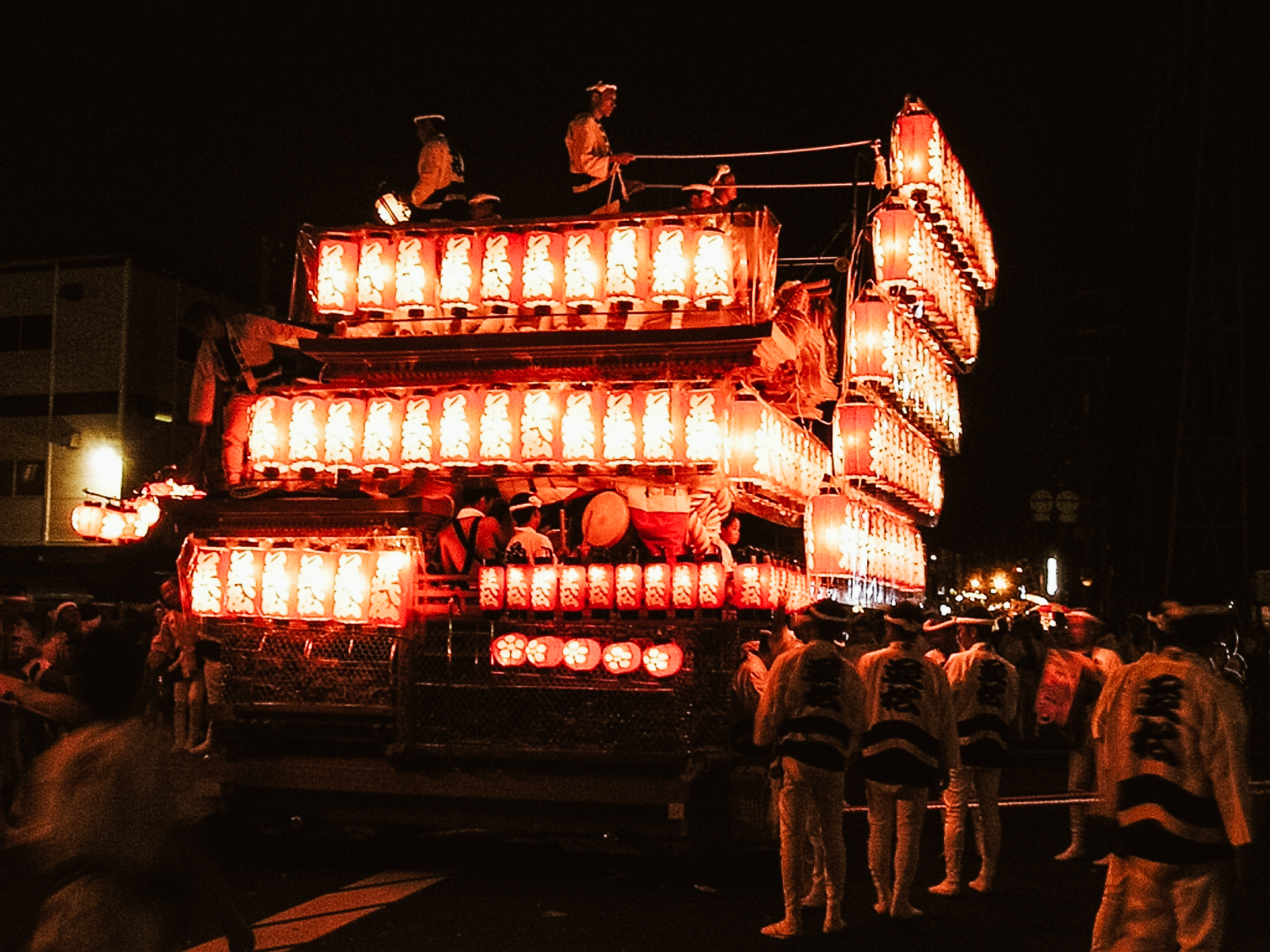
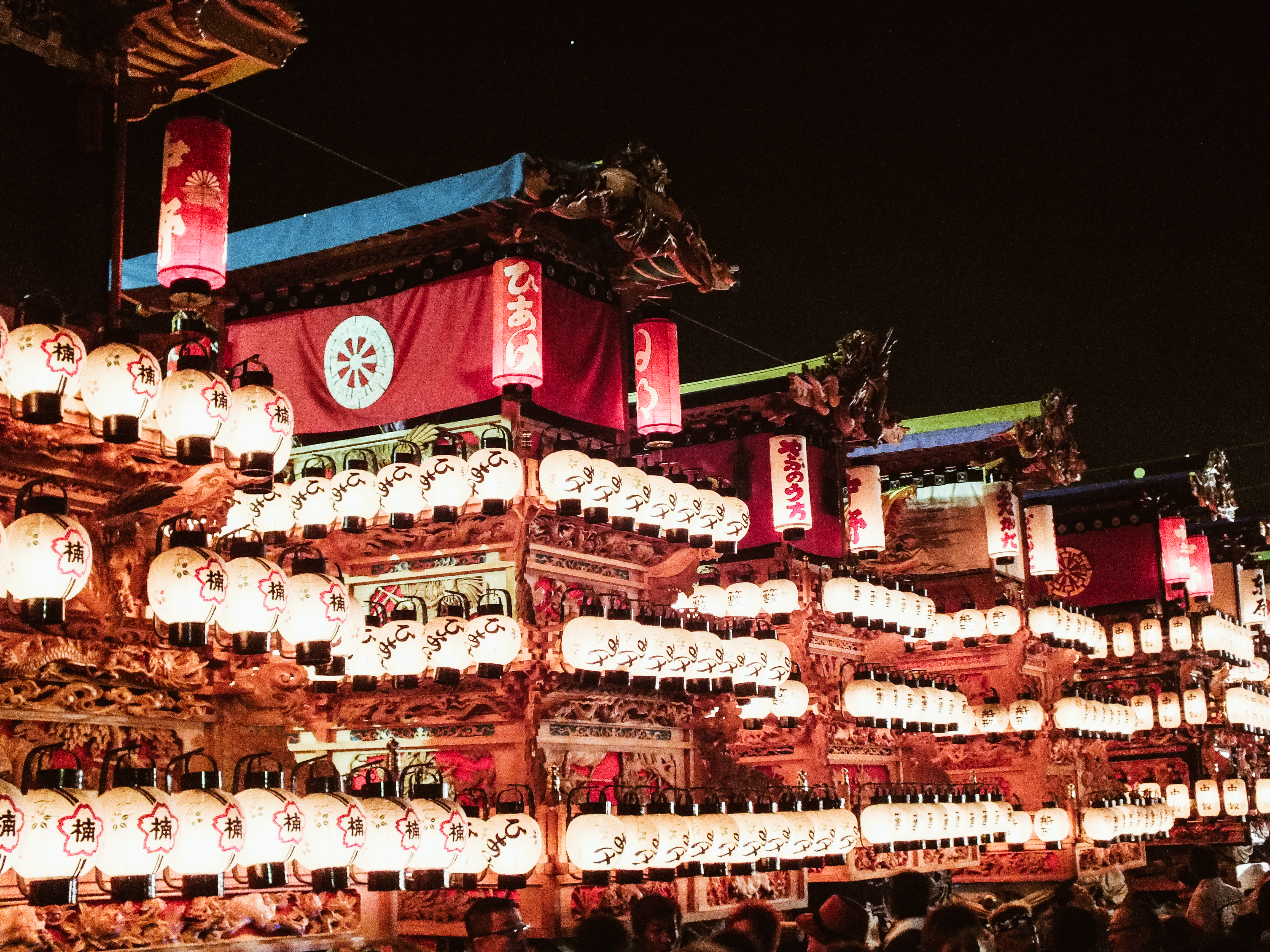
photo credits: rove.me, Gavin Kealy
More than 500,000 visitors come to Kishiwada to experience the thrill of this celebration, what do you think? Do you find this parade electrifying?[:ja]Let's return to talk about Japanese festivals and today we talk about the Kishiwada Danjiri Matsuri.
Yuki-Onna: the mysterious incarnation of the Japanese winter
In the endless world of yokai (supernatural creatures of the Japanese tradition), the figure of Yuki-Onna (雪女) stands out. Legendary snow woman, with her icy and lethal charm, embodies the terrible beauty of winter in the mountains of Japan.
Despite being known by different names and stories in the various prefectures, this character is renowned above all in the coldest and most inaccessible areas of the archipelago.
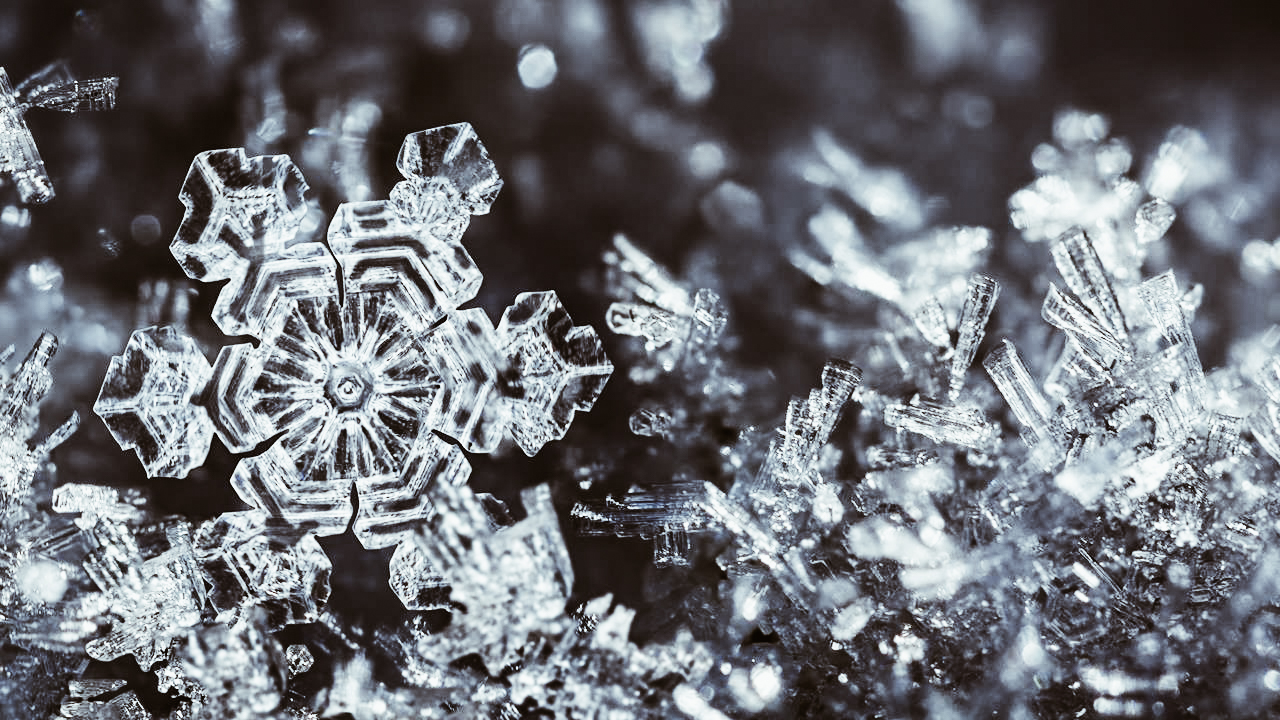
The Yuki-Onna is described as a beautiful woman with white skin, which appears on mountain trails and in snowstorms. She is dressed in a light white kimono or naked and covered only by very long hair, black or white depending on the legends. Ethereal and floating apparition in the snowy landscape on which it leaves no footprints, it can suddenly disappear turning into a cloud of fog or very fine snow.
Yuki-Onna: the Origins
The origin of this figure, like other yokai, is lost in the most ancient times. The first written trace of its history is found in the Sōgi Shokoku Monogatari, dating back to the Muromachi period (1333-1573). Here the monk Sogi describes the encounter with a woman of extraordinary beauty during his stay in the province of Echigo (current prefecture of Niigata). This mysterious woman was dressed in white, tall and with a very pale complexion and long white hair. From a young appearance, she mysteriously appeared one morning in the frozen garden of the monk. However, it disappeared just as mysteriously under the incredulous gaze of man.
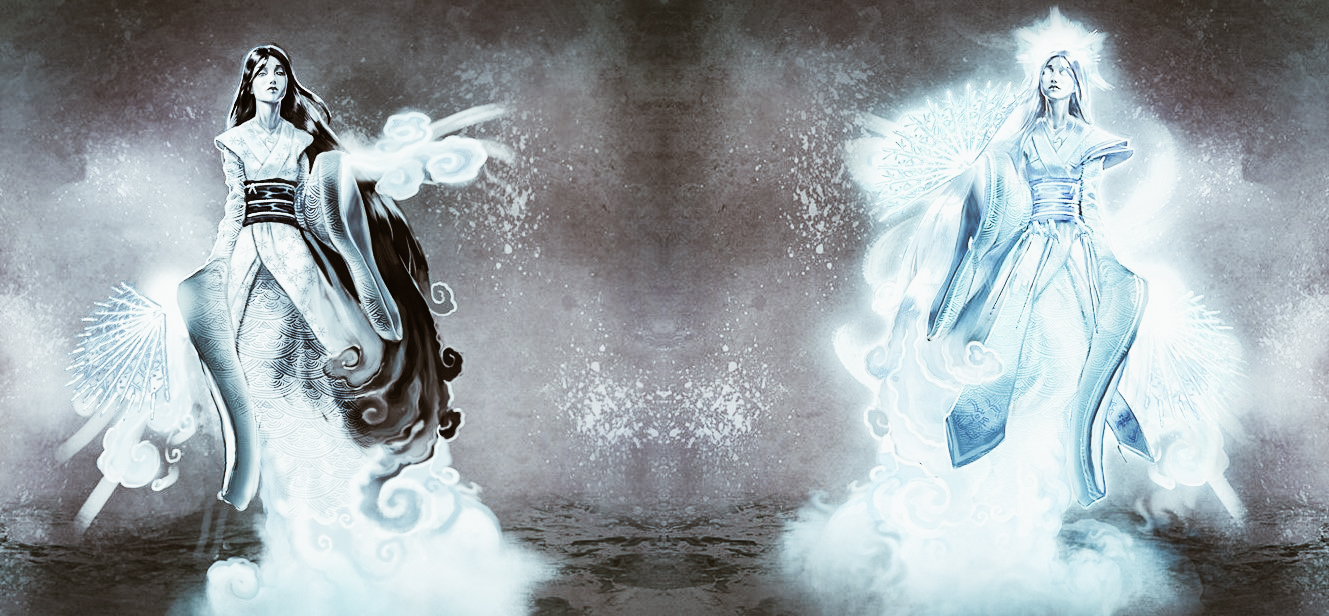
photo credits: smitefire.com
The two faces of winter
Like the winter that can manifest itself with a dazzling and serene splendor or with a cruel and lethal force, so is the Yuki-Onna. Sometimes it appears as a ruthless predator that attracts lost travelers into the storm to feed on them with their life energy. At other times it appears as a benevolent presence or even in its turn seduced by human charm.
In the most ancient stories, the monstrous and destructive aspect prevails. In fact, in these stories, parents who have lost their children in the mountains are approached by a woman. She asks them to pick up a child she can't bring herself. The unwary who accept this invitation are destined to freeze to death, overwhelmed by the fatigue of carrying a heavier burden at every step.
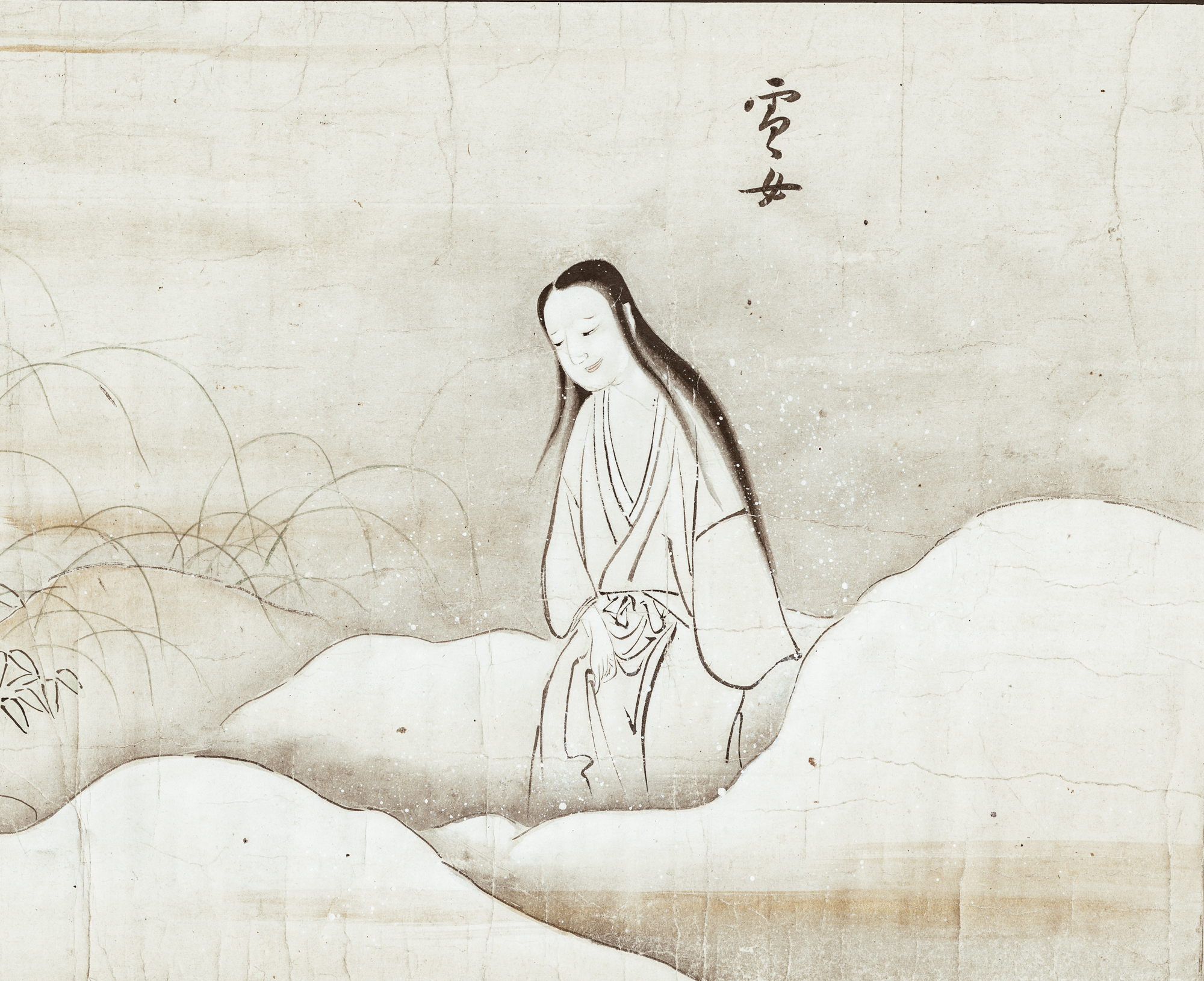
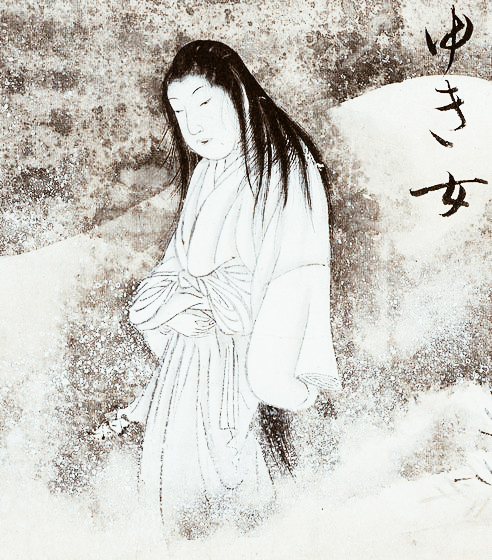
photo credits: wikipedia.org
Or in the stories, the Yuki-Onna seduces men subjugated by its otherworldly charm. They end up succumbing to his mortal kiss, able to drain their life force and freeze their hearts. Or again in dramatic stories, in which Yuki-Onna does not simply wait for the passage of bewildered travelers. Here, in fact, it enters the houses forcefully, opening doors and windows in the form of violent snowstorms, killing the unfortunate inhabitants.
In the West, we know a more romantic aspect of this reading. This is mostly thanks to the work of Patrick Lafcadio Hearn, a Ireland-born journalist and writer from Japan, also known as Koizumi Yakumo (小泉八雲).
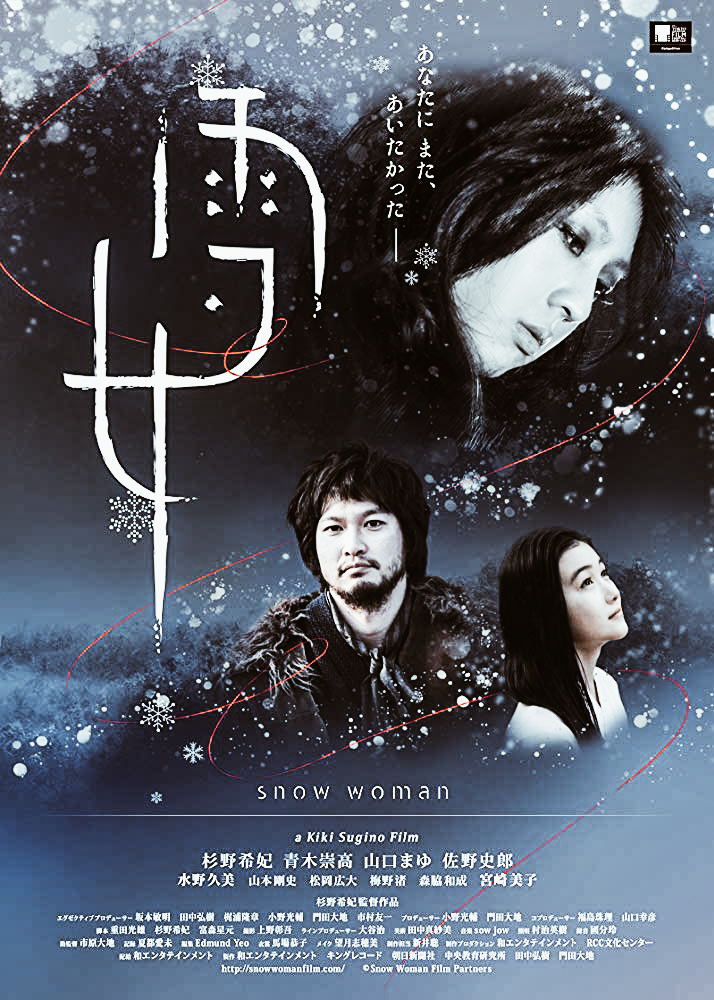
photo credits: letterboxd.com
The Lafcadio version
"Kwaidan: Stories and Studies of Strange Things" is a 1904 work containing a collection of popular beliefs and also an interpretation of the culture and customs of Japan. Here the legend narrated by Hearn speaks of two woodcutters, Elder Mosaku and his young apprentice Minokichi, who return home after a day's work on a cold evening. The two characters surprised by a violent snowstorm find shelter in a hut near a river. Afterward, the two men lay on the floor of the hut and, overcome by fatigue, they fall asleep. During the night Minokichi is awakened by an icy wind, which seems to have opened the door and windows of the hut. Still confused by sleep and believing he is dreaming, he sees a woman dressed in white and with long hair, bending over Mosaku, intent on breathing a cold mist like breath over him.
When the woman turns to Minokichi, the young man remains enchanted by her incredible beauty. However, he cannot sustain that look that inspires an unspeakable terror. Softened by the youth and the attractiveness of the boy, the woman decides to spare his life on condition that he never reveals to anyone the existence of such a creature. If he ever spoke to any of those events, his death would be certain.
The following morning a boatman, owner of the hut, finds in his interior the now frozen body of the elderly Mosaku, but manages to rescue Minokichi, now semi-frozen to safety.
A year later...
Having overcome the terror and exhaustion of that terrible night, the young man marries a beautiful young woman named O-Yuki. Suddenly appearing in his village she was immediately well-liked by everyone for her charm and her gentle manner. For many years the two live a happy marriage, blessed by the girl's inexplicable eternal youth, whose beauty seems to endure unchanged over time despite the birth of ten children.
Until one-day Minokichi, forgetting the promise he made, recklessly tells his wife of a supernatural creature he met many years before and that somehow seems to remind him of his charming bride. To his immense surprise, O-Yuki, suddenly transfigured by anger, reveals herself to be the woman he met that night. After having reproached her husband for not having been able to keep the promise of secrecy made so many years before, she decides to spare his life for the sake of their children. So, after warning him to take good care of them, she disappears forever.
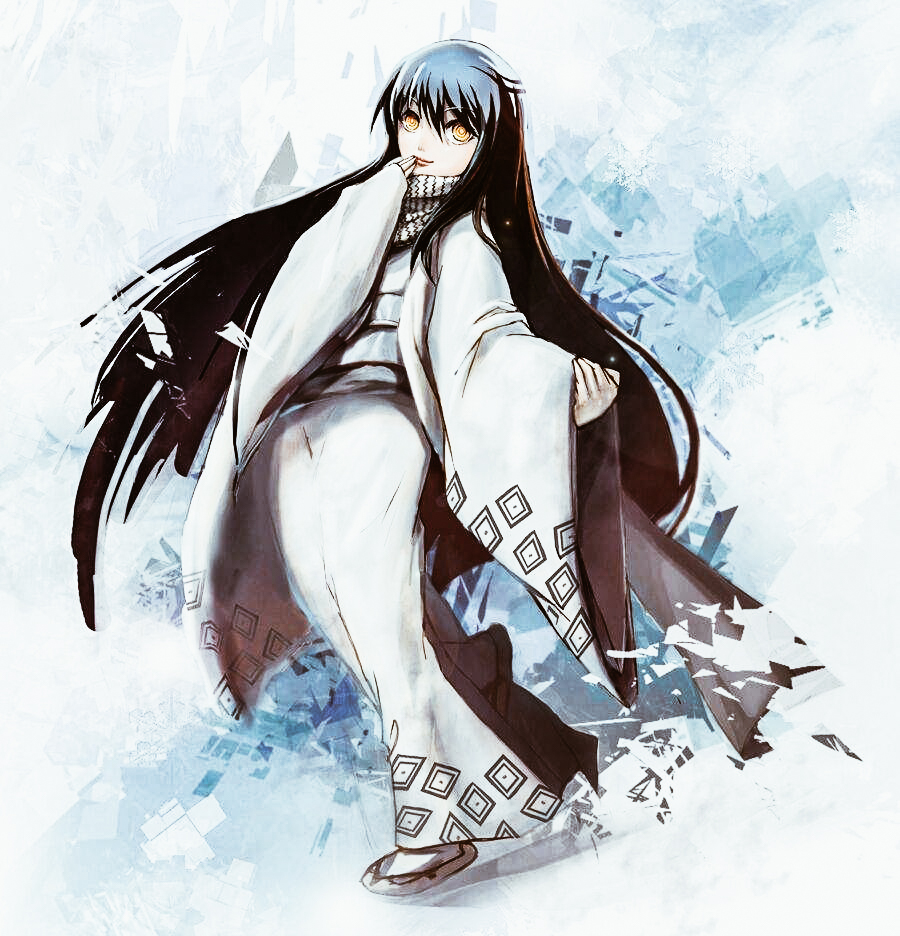
photo credits: aminoapps.com
Yuki-Onna in the contemporary age
Like the bride of Minokichi, the legend of Yuki-Onna, cruel and romantic at the same time, seems to preserve its charm over the centuries.
In fact, in contemporary times it has inspired numerous films. We remember in fact Kwaidan (怪怪) of 1965, directed by Masaki Kobayashi, winner of the special prize of the jury at the Cannes Festival. Kwaidan was also in the running for the Academy Awards with a nomination for Best Foreign Language Film.
The success of this film was followed, in 1968, by Kaidan Yukijoro by Tokuzô Tanaka, until 2016 with Yuki-Onna, directed and performed by Kiki Sugino.
The beautiful and lethal snow woman, in her innumerable variations, then appears as a protagonist or leading figure in a vast range of video games, anime and manga. Nurarihyon no Mago or Ranma ½, just to name a few. However, its timeless charm will continue to enchant us for a long time, with its eternal, candid winter.
Japan Folklore: Oni
Oni, yōkai in Japanese folklore
From a benevolent creature to an evil one. This is the slow transformation of the Oni (鬼), the Japanese mythological creatures that we Westerners call "demons", "trolls" or "orcs".
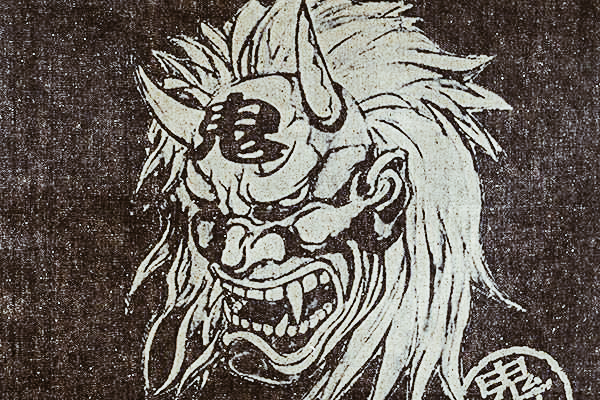
photo credits: tateandyoko.com
Before the Heian era, the Oni were good spirits able to ward off evil. However, during this era, they were relegated to the role of guardians of hell or torturers of damned souls. An example of this is the aka-oni (red demon) and the ao-oni (blue demon) described in the Buddhist tradition, which take on a negative connotation and become spirits to be kept away. In fact, they are considered as carriers of misfortune or agents of natural disasters.
Their appearance is certainly not reassuring. In fact, they are said to have animalistic and monstrous features, sometimes with many eyes and colored skin (red, blue, black, pink or green). They can also be clawed, wear tiger skin and carry kanabō (金棒, literally: "metal stick", a spiked war bat used in feudal Japan by the Samurai).
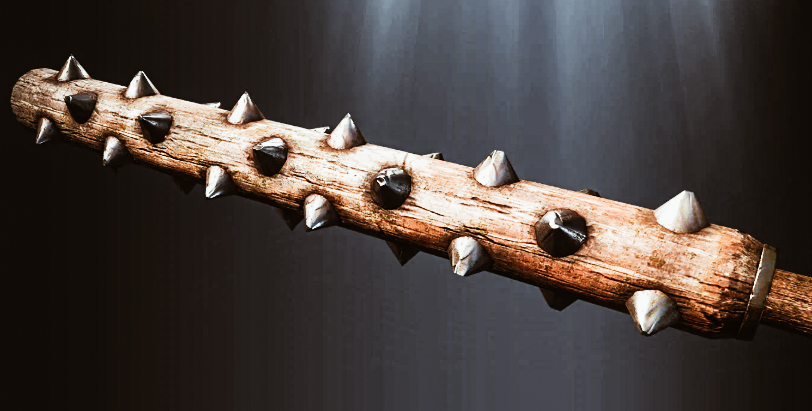
photo credits: forhonor.ubisoft.com
Demon Get out! Luck get inside!
In the Nara era, to avert the disasters that these spirits could provoke, people used to practice oniyarai (追儺), a ritual aimed at driving out the demon.
On the last day of each year, a person used to dress in the demon's clothes and was chased away with peach bows and reeds. Over time this custom turned into the Setsubun celebrations, in which people throw soybeans out of the house saying: "Oni wa soto! Fuku wa uchi! "(Oni out! Luck inside!).
Despite being considered evil spirits, in tradition, there are still traces of their benevolent nature. We find these during the parades when some men wear the Oni costume to ward off bad luck. They are also depicted on the tiles of some buildings for the same reason.
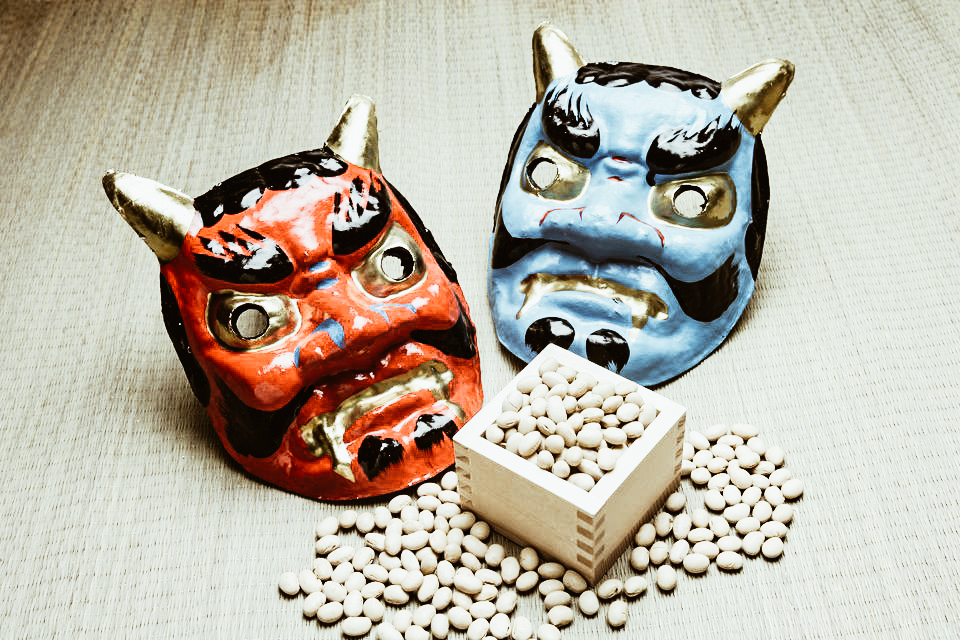
photo credits: tripsavvy.com
The many curiosities of modern culture
Today we meet these demons not only in folkloristic stories and nursery rhymes for children but also as protagonists of proverbs! In fact, it is said that "Even in the eyes of the oni tears arise" (鬼の目にも涙) to indicate that even the hardest heart sometimes feels pity. Another proverb is "The wife of an oni becomes an oni divinity" (鬼の女房鬼神がなる) which refers to our "disciple surpasses the master".
Of course, it was unthinkable not to use such a particular figure in animes and mangas! There are endless references to these spirits, and one of the most famous and well-known is Lamù, the main character of Rumiko Takahashi's manga. But it is not the only one. In fact, even in The Blue Seal by Chie Shinohara the Queen of the Oni is the protagonist. There is also Shutendoji by Gō Nagai whose work title refers to the legend of an oni of the same name.
Among the most played and entertaining horror/adventure video games we cannot forget Ao Oni. Here the main antagonist is a blue demon whose anime adaptation was broadcast in Japan between October 2nd, 2016 and January 8th, 2017. The 13 3-minute long episodes were also streamed in Italy under the title Aooni The Blue Monster (あおに〜じ・あにめぇしょん〜). Despite its simplicity, Ao Oni is terrifying thanks to the background music that gives the videogame the right scary atmosphere!

photo credits: giantbomb.com
Japan Folklore: Nippombashi Street Festa
photo credits: jnto.go.jp
In Osaka, anime and manga come to life
Every year since 2005, between early days and mid-March, the streets of Den Den Town located between Ebisucho Station and Nihonbashi are closed to car traffic for the biggest cosplay event in all of Japan: the Nippombashi Street Festa (日本橋ストリートフェスタ).
Den Den Town is the electronic district of Osaka that, thanks to its toy stores, video games stores and computer stores, has begun to attract a large number of manga and anime fans, soon turning into one of the "sacred" destinations for Otaku. Each year the festival is enhanced by attracting not only the local but also a more international audience!
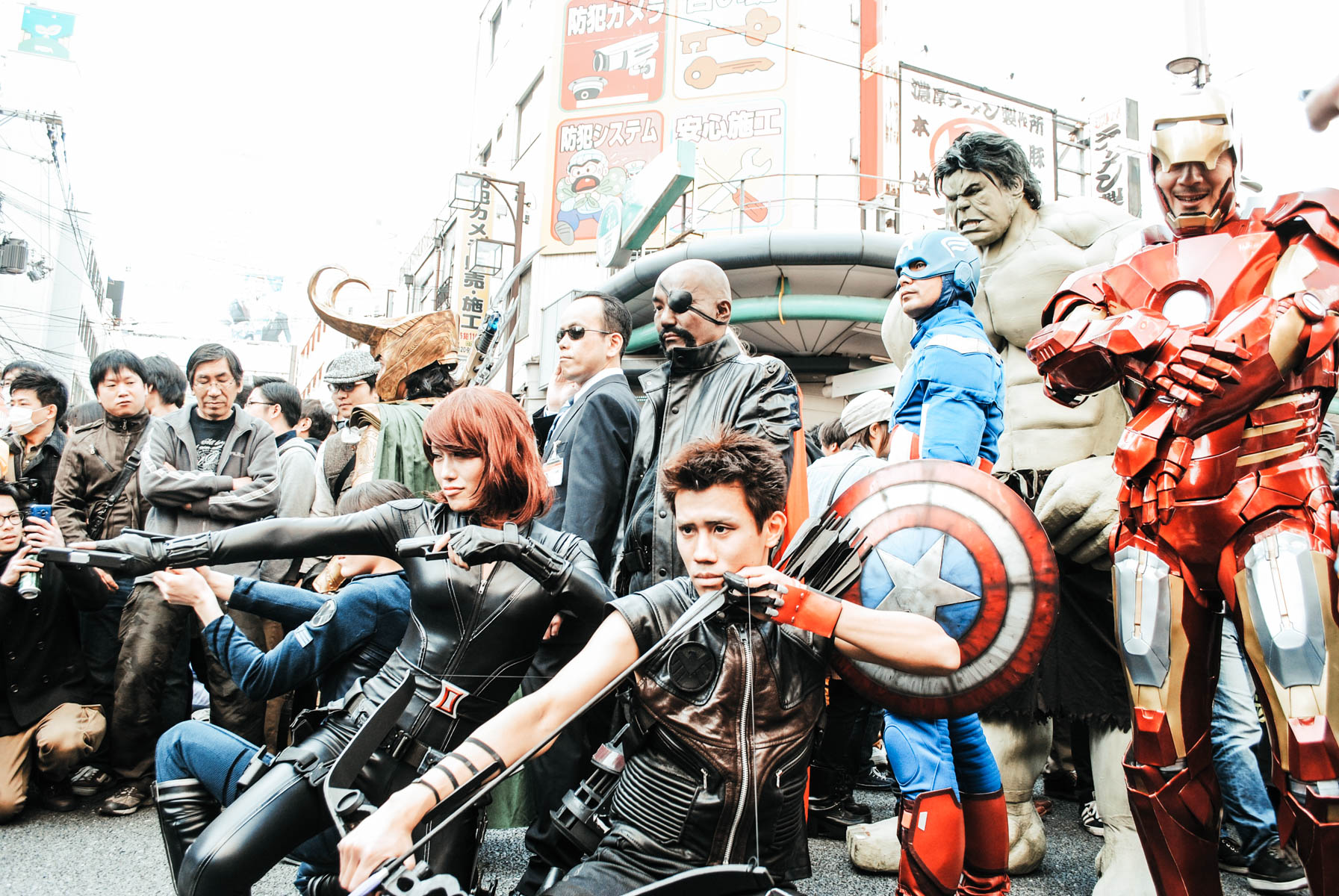
photo credits: reddit.com
The Festival begins!
Preparations for the event start around 11:00 am with the roads closing to traffic. Here, above the street the main stage on which guests, cosplayers and sponsors alternate throughout the day is built.
The opening ceremony begins at 12.00 pm when a road is created for the parade of the 1,000 best cosplayers from around the world. After the show, cosplayers perform and pose for all those wishing to approach their favorite character. Many of them take advantage of the event to promote their socials accounts, writing their address on whiteboards or signs placed next to them while they are immortalized in the poses studied in advance.
Obviously the event is not open only to professionals, but hundreds and hundreds of people wear their own costume. It doesn’t matter if this belongs to pop culture, anime, manga, video games or even cartoons and characters from American comics (especially Marvel, Adventure Time and Star Wars), almost 10,000 people a year turn into their own hero! Of course, the festival is free, but if you want to participate in the parade, an entry fee of around 1,500 yen is needed.
The event is also the perfect opportunity to find unique designs by Nippombashi Street Festa and exclusive goods.

photo credits: nippombashi.jp
The cultural exchange project between Japan and France and an exceptional ambassador
From 2018, year of the 160th anniversary of friendship between France and Japan, the 「Japan-France pop culture Exchange project」was promoted in order to deepen the cultural exchange between manga, animation, music and other aspects of Japanese pop culture with the France in collaboration with the「Japan Expo」.
To disseminate the event and make it even more alive, KAMIJO, the talented Japanese artist who became particularly famous in France, was chosen as the project's ambassador.
This year the Nippombashi Street Festival will be held on March 9th and will be the perfect opportunity to immerse yourself not only in the magical world of fantasy, but also in the musical world!









